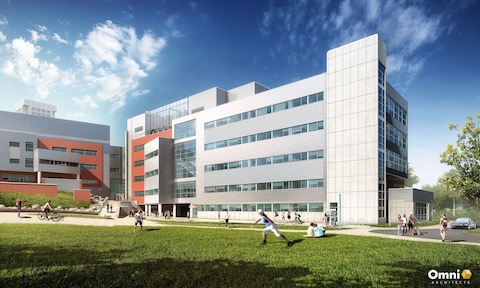Phase 2 of EKU Science Building bids below estimate

Phase 2 of Eastern Kentucky University's New Science Building bid on October 9, coming in at $46,900,000 - nearly $6 million below the original construction estimate of $52,413,396. The 158,000 SF addition to the Phase 1 building will include the Departments of Biological Sciences and Geography and Geology. The total project cost for Phase 2, including furnishings and fixtures, is $66.3 million.
According to Principal in Charge Eric Zabilka, this successful estimate was achieved in a very strategic manner. “We used a number of strategies to manage the bidding process to ensure we received the most competitive bids possible.” Some of the strategies Zabilka refers to include:
- Closely monitoring the progress of other significant projects and adjusting the schedule to make sure the Science Building was the first major project bid. This ensures that hungry contractors as opposed to those that already have enough work.
- Making bid documents as simple and straight-forward as possible. This makes it easier for the contractors, and can affect their pricing. Examples include minimizing the number of alternates, the number of line items on the bid form, and how the drawings are organized internally.
- Reaching out to the contractor community before the project was advertised to make sure they knew the project was on the horizon. Omni kept them up to date on the schedule, explained the scope of the project, and communicated the design team’s efforts to provide clear and complete documents.
- Emphasizing the unique circumstances of having Phase 1 available as an example of what is expected for Phase 2. This went a long way to eliminating the "fudge factor" in the contractor's bids. They didn't have to guess how much wood grain variation was acceptable in the maple lab cabinets - and add enough money to the bid to cover their guess - because they could look at the Phase 1 cabinets and know exactly what we expect.
- Making the Phase 1 building very available to the contractors during the bidding process so they take advantage of it as a prototype. Instead of one facility tour at the pre-bid meeting, which is typical, Omni held four.
- The design team was very clear with the contractors about lessons learned from Phase 1, and explained how the design and documents were revised to eliminate these challenges on Phase 2. Identifying the design team’s concerns also helps reduce the fudge factor.
- The design team was very available during the bidding process. They responded to questions quickly and provided many means and points of contact to make sure they could always get their questions answered with ease. All of this was part of an effort to communicate the design team’s desire to help the contractors bid successfully.
- Demonstrating appreciation for the contractor's time and making efforts to thank them when they identified issues or questions or made time to talk to us. Again, it was all part of an effort to say to them "you're our partners, and without you, we can't have a successful project!"
According to Principal in Charge Eric Zabilka, this successful estimate was achieved in a very strategic manner. “We used a number of strategies to manage the bidding process to ensure we received the most competitive bids possible.” Some of the strategies Zabilka refers to include:
- Closely monitoring the progress of other significant projects and adjusting the schedule to make sure the Science Building was the first major project bid. This ensures that hungry contractors as opposed to those that already have enough work.
- Making bid documents as simple and straight-forward as possible. This makes it easier for the contractors, and can affect their pricing. Examples include minimizing the number of alternates, the number of line items on the bid form, and how the drawings are organized internally.
- Reaching out to the contractor community before the project was advertised to make sure they knew the project was on the horizon. Omni kept them up to date on the schedule, explained the scope of the project, and communicated the design team’s efforts to provide clear and complete documents.
- Emphasizing the unique circumstances of having Phase 1 available as an example of what is expected for Phase 2. This went a long way to eliminating the "fudge factor" in the contractor's bids. They didn't have to guess how much wood grain variation was acceptable in the maple lab cabinets - and add enough money to the bid to cover their guess - because they could look at the Phase 1 cabinets and know exactly what we expect.
- Making the Phase 1 building very available to the contractors during the bidding process so they take advantage of it as a prototype. Instead of one facility tour at the pre-bid meeting, which is typical, Omni held four.
- The design team was very clear with the contractors about lessons learned from Phase 1, and explained how the design and documents were revised to eliminate these challenges on Phase 2. Identifying the design team’s concerns also helps reduce the fudge factor.
- The design team was very available during the bidding process. They responded to questions quickly and provided many means and points of contact to make sure they could always get their questions answered with ease. All of this was part of an effort to communicate the design team’s desire to help the contractors bid successfully.
- Demonstrating appreciation for the contractor's time and making efforts to thank them when they identified issues or questions or made time to talk to us. Again, it was all part of an effort to say to them "you're our partners, and without you, we can't have a successful project!"
